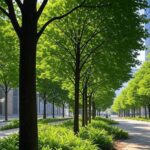Environmental and Social Benefits of Sustainable Urban Drainage Systems (SUDS)

Sustainable Urban Drainage Systems (SUDS) are transformative in managing stormwater while delivering significant environmental and social benefits. By mimicking natural water cycles, SUDS not only mitigate flooding and pollution but also enhance urban ecosystems and community well-being. This article explores these benefits, making it a valuable resource for ecologists, urban planners, and community stakeholders seeking to understand the broader impacts of SUDS.
Environmental Benefits
1. Flood Risk Reduction
SUDS reduce peak runoff by storing and slowly releasing stormwater, alleviating pressure on urban drainage systems. Components like detention basins and permeable pavements can reduce runoff volumes by 50-90%, preventing downstream flooding during heavy rainfall events. This protects infrastructure and ecosystems from erosion and overflow damage.
2. Improved Water Quality
Through natural filtration processes, SUDS remove pollutants such as sediments, oils, and heavy metals from stormwater. For example, bioswales and constructed wetlands achieve 60-80% removal of total suspended solids (TSS) and 40-70% for hydrocarbons, ensuring cleaner water enters rivers and groundwater systems. This supports aquatic ecosystems and reduces treatment costs.
3. Groundwater Recharge
Infiltration-based SUDS, such as permeable pavements and infiltration trenches, promote water seepage into the soil, replenishing aquifers. Studies indicate that well-designed systems can recharge 30-50% of captured rainwater, critical in areas facing groundwater depletion due to urbanization.
4. Biodiversity Enhancement
SUDS like rain gardens and constructed wetlands create habitats for native flora and fauna. Vegetated systems support pollinators, birds, and amphibians, increasing urban biodiversity. For instance, green roofs can host over 50 plant species, fostering ecosystems in dense cities where green spaces are limited.
5. Carbon Sequestration and Air Quality Improvement
Vegetated SUDS components, such as green roofs and swales, sequester carbon through photosynthesis and reduce urban heat islands by up to 2°C. They also filter airborne pollutants, improving air quality. A single green roof can offset 0.1-0.2 tons of CO2 annually, contributing to climate resilience.
Social Benefits
1. Enhanced Urban Aesthetics
SUDS integrate green infrastructure, such as rain gardens and green roofs, into urban landscapes, creating visually appealing spaces. Projects like Augustenborg in Malmö, Sweden, demonstrate how SUDS transform concrete-heavy areas into vibrant, green public spaces, boosting community pride and property values.
2. Improved Community Well-Being
Access to green SUDS features, like detention basins doubling as recreational parks, promotes mental and physical health. Studies show that urban green spaces reduce stress and encourage physical activity, with 20% higher usage of SUDS-integrated parks compared to traditional paved areas.
3. Community Engagement and Education
SUDS projects often involve local residents in design and maintenance, fostering a sense of ownership. Initiatives like the Lost Effra project in London engaged communities to install rain gardens, raising awareness about sustainable water management and empowering residents to contribute to environmental solutions.
4. Economic Benefits
By reducing flood damage and sewer maintenance costs, SUDS save municipalities significant expenses. For example, the Basildon Hospital retrofit in the UK avoided £4 million in flood-related damages. Additionally, SUDS can increase local property values by 5-10% due to enhanced aesthetics and reduced flood risk.
5. Climate Adaptation and Resilience
SUDS help cities adapt to climate change by managing increased rainfall intensity (projected to rise 20% by 2050). By integrating SUDS, communities build resilience against extreme weather, ensuring safer and more sustainable urban environments for future generations.
The environmental and social benefits of SUDS extend far beyond water management, offering a holistic approach to urban sustainability. From reducing flood risks and enhancing biodiversity to improving community health and economic savings, SUDS are a cornerstone of resilient urban planning. By adopting these systems, cities can create greener, healthier, and more inclusive spaces, inspiring stakeholders to prioritize sustainability in urban development.

